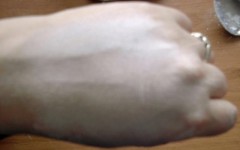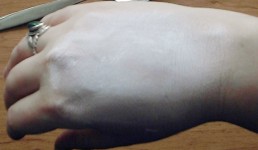http://www.marquise.de/en/1700/kosmetik_4.shtml
White paint as powder
Most of the recipes for white paints consist of instructions as to how one pours acid over metal shavings and thus gets metal oxydes which, when dried, cleaned and powdered, serve as pigments. Now apart from the fact that I don't feel like applying such awful stuff as lead oxyde to my face, I don't feel much inclined to handling acids, either. There's a much, much simpler method: Go to the chemist's or, better yet, a pigment shop that caters to painters, and simply buy talc, zinc white, or titanium white. It's already as pure and powdery as it can get.
Only talc is exactly the same as in the recipes, minus the trouble of having to rinse it with vinegar: The talc you can buy is already gleaming white and doesn't need rinsing. I've used zinc white instead of tin white: It does, like tin white, not cover very well and is proven harmless. It's widely used in the cosmetics and pharmaceutical industry. It's not historically correct (known since c. 1830). Titanium white serves instead of lead white: It covers as well if not better than lead white, but is harmless... and even less historically correct since it wasn't used until the early 20th century. So what? Nobody can tell - the effect, if applied in a historically correct manner, should be the same, and non-toxic goes a long way.


It doesn't show all too well in the pictures, but talc (left) still lets some skin colour show through, while titanium white is reminiscent of clown's paint. Actually I bet that's what clown's white is made of.
Instead of the instructions in the recipe book that tell you to take some of the white powder onto a greased finger and then apply it, I've found it easier to smear some pomad on the face and then apply the stuff with a brush. A thin film of greasy pomad on the skin will make the powder stick where it's supposed to be. And if I say stick, I mean stick: I needed a lot of soap to get the titanium white off again.
The greased-finger method tends to produce an uneven result: The mixture of pomad and powder is relatively dry and therefore difficult to distribute. The latter method is not without problems, either. It is not proven historically correct, but what's more, the powders are so fine that you should take care not to breathe while brushig them on. Zinc oxide, for instance, produced a rather unpleasant metallic taste at the back of my mouth. While zinc and titanium oxyde are harmless as ingredients of cream, they are harmful if breathed in in larger quantities.
To get an effect as towards the end of the film "Elizabeth", where a maid smears a bit of creamy-soft, but highly covering paint onto the queen's hand, you'd have to mix the pigment not with pomad, as the 1805 recipes suggest, but something much more fluid, such as oil. That may be historically correct as well and get better results, but the book doesn't mention anything like it.
White paint pellets
These seemed to be a good idea for storage and especially for transport when going to re-enactment events. More than once, the cork or glass lids have come off powder jars during transport... guess what the result was.
The recipe says to mix some traganth with water and let it rest overnight, then pour the solution over the white powder, stir it into a thick paste and spread that over a piece of white paper.
Traganth comes as powder - not cheap, but a little goes a long way. Half a teaspoon of it in a cup of water should, if stirred well and let rest overnight, become a thick fluid that serves for 200-400g of white powder. I can't tell exactly because I used too much traganth water and still had a lot of it left. The reicpes don't give any amounts, after all. Having some left isn't the problem, but pouring too much over the powder and having no powder left to make up for it is. Spreading it onto paper didn't help much: The stuff took ages to dry, and then the soaked paper had become stuck to it. Period paper was different, of course.
So, put about a fourth of the powder aside at first, use a small amount of traganth water and try to get the kneadable consistency of bread dough. If it doesn't stick on the hands, you've got it right. If it does, use the rest of the powder as you would use flour when kneading bread: Put some on your hands and knead more and more of it into the dough until it doesn't stick anymore. Then you can roll the pellets. They should be about the size of peas. Put them onto a plate with a bit of space between them and leave them in a warm and dry place to dry. Depending on the place (heated living room or summer sun?), this may take a couple of days or even weeks. You may want to accelerate the process, at least until the outside feels dry, by putting the pellets in the oven at a low temperature for some hours. You should still let them completely dry out in the open for some days, but at least they won't stick together anymore, so you can leave them to dry in a heap.
Carmine red
The recipe in short form: 2 ounces of cochenille, powdered, cook in 4 maaß of water, add one drachme alum, strain through a piece of fabric. Put in cold place and add 2 drops of tin solution every 2 hours, let settle, remove the clear liquid and dry the sediment. Which is supposed to become a powder when dry.
A pigment lexicon said that the resulting colour would be scarlet. I've used half the given amounts because it was just a test and because cochenille is expensive. So, I powdered 30g of cochenille in a mortar and poured it into 3 litres of boiling water and let it cook for 5 minutes. My, that cochenille stinks! A bit like socks that have been in a moist cellar for too long after having been worn for 3 weeks on end. I added 2g alum, but the smell didn't get better. I strained the stuff into a plastic bucket and put it out on the balcony (it was winter, but not frosty). I didn't know what "tin solution" was but decided, after studying some dyeing recipes and similar, that it must be Tin(II)dichloride. However, the stuff came in little crystals - so how much of that is two drops? I tried about 1/8 of a teaspoon. Careful: The stuff is caustic!
After that, the soup spent a week on the balcony, and lo and behold, red stuff began to set. Above that was reddish, but clear liquid which I carefully skimmed off. It's good to have a high, narrow vessel so that the clear stuff stands high over the sediment. It's a bit like diving over sandy ground: One false movement and the stuff rises up and forces you to wait unil it has settled again. When I couldn't skim any more off, I stirred the rest up good and poured it into a soup plate to dry.
The result wasn't a powder, but a firm layer that I had to break up to get it out of the plate and then pulverise in a mortar. It wasn't scarlet (which I imagine as a very brilliant red), either, but almost exactly the colour of the carmine red pot in my old school watercolour set, i.e. a rich, dark red. Not wine-dark, but not brilliant, either.
Meanwhile I've found a stuff named carmine naccarat in a pigment shop which is made roughly as in the recipe, minus tin solution (which didn't seem to have any effect on the colour, anyway). That looks more like scarlet. So what's the correct colour, the one that Mr Tromdorff would have got? Did I do something wrong to get such a dark red, or was that exactly right? Should I have used softer water, as the recipe said (but which I forgot), was the dosage of the tin solution wrong, or was tin(II)dichloride the wrong stuff? Nobody knows, nobody can know.
BTW, little hint: I've saved the stuff that was in the fabric I'd strained the solution through and let it dry. I've also saved the red, Campari-coloured clear liquid I've skimmed off. I'll use both for dyeing fabrics and soaps, instead of the clear water normally used. Or maybe I'll simply serve it to unwelcome guests as Campari. ;)
Sandalwood red
The recipe said to pour alcohol over bruised sandalwood and let it rest for a week in a warm place. Then you let the alcohol evaporate so that a kind of resin stays at the bottom of the vessel, which you let dry.
Since i don't have a distillery handy, letting the alcohol evaporate is a bit tricky. The resin part seems to work, though: There is sticky reddish stuff at the bottom. After a while - the alcohol had turned brownish but didn't look as if it was becoming less - I lost my nerve and poured it away. I found a hard layer at the bottom which i saved pounded up in a mortar. The red has a brownish hue which I feel is not what was intended. Still, I mixed it with some talc to get a soft pink. Not bad, but judging from what the book says, brilliant red was preferred in period. Nowadays, it's relatively easy to obtain pulverised sandalwood, which is somewhat redder than the stuff i'd got and therefore, it may be a good idea to use the stuff as is.
For use as paint, the red powder was mixed with different amounts of white talc so that you got different nuances. On a face painted white, you won't need much red, i.e. the nuances should go from pale to medium pink. You'd apply the palest nuance first, then put a smaller patch of deeper pink onto it etc. to achieve a blending effect. The recipe suggests mixing the coloured powder with traganth water, filling it into pots and letting it dry. The effect would probably be similar to modern rouge pots. I imagine that you could also make pellets, but as that would leave a lot of the mixture sticking on my fingers or wherever, and the red pigments are expensive to make, I've preferred to leave them as a powder.
4. Appendix: Historical measurements and Links
Measurement units used in the recipes
| Gran | 0,0683 g |
| Drachme | 3,65 g |
| Loth | 14,6 - 17,5 g |
| Unze (ounce) | 29,2 g |
| Pfund (pound) | 350,8 g |
| Nösel (Nößel) | 0,418 l |
| Maaß (Maß) | 1,023- 1,41 l |
Source: German Genealogy: old units. Some units are diffent from region to region. I've used the apothecary's units wherever possible since those were probably used by the author.
Links to suppliers and info
Omikron GmbH - mail and online ordering of chemicals and cosmetics ingredients.
Kremer Pigmente - Pigment and dye dealer with shops worldwide and online ordering. Also comes with a quite good pigment lexicon.
No comments:
Post a Comment